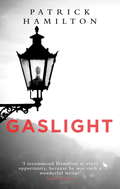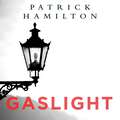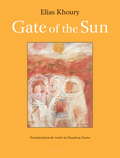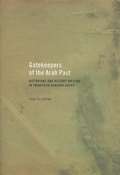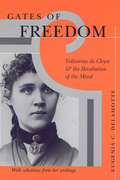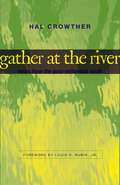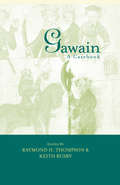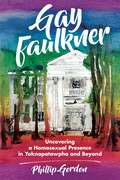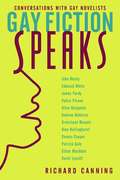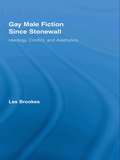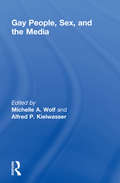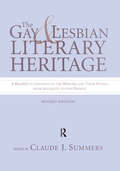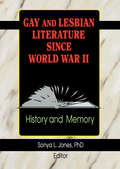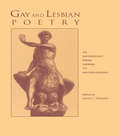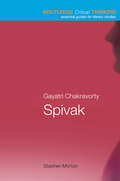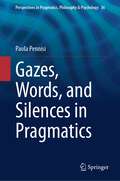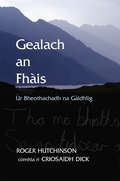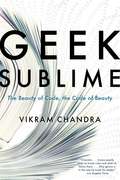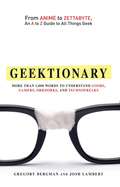- Table View
- List View
Gaslight
by Patrick HamiltonThis classic Victorian thriller was first produced in 1935. Jack Manningham is slowly, deliberately driving his wife, Bella, insane. He has almost succeeded when help arrives in the form of a former detective, Rough, who believes Manningham to be a thief and murderer. Aided by Bella, Rough proves Manningham's true identity and finally Bella achieves a few moments of sweet revenge for the suffering inflicted on her.
Gaslight (G - Reference,information And Interdisciplinary Subjects Ser.)
by Patrick HamiltonThis classic Victorian thriller was first produced in 1935. Jack Manningham is slowly, deliberately driving his wife, Bella, insane. He has almost succeeded when help arrives in the form of a former detective, Rough, who believes Manningham to be a thief and murderer. Aided by Bella, Rough proves Manningham's true identity and finally Bella achieves a few moments of sweet revenge for the suffering inflicted on her.
Gate of the Sun
by Humphrey Davies Elias KhouryGate of the Sun is the first magnum opus of the Palestinian saga. After their country is torn apart in 1948, two men remain alone in a deserted makeshift hospital in the Shatila camp on the outskirts of Beirut. We enter a vast world of displacement, fear, and tenuous hope. Khalil holds vigil at the bedside of his patient and spiritual father, a storied leader of the Palestinian resistance who has slipped into a coma. As Khalil attempts to revive Yunes, he begins a story, which branches into many. Stories of the people expelled from their villages in Galilee, of the massacres that followed, of the extraordinary inner strength of those who survived, and of love. Khalil--like Elias Khoury--is a truth collector, trying to make sense of the fragments and various versions of stories that have been told to him. His voice is intimate and direct, his memories are vivid, his humanity radiates from every page. Khalil lets his mind wander through time, from village to village, from one astonishing soul to another, and takes us with him. Gate of the Sun is a Palestinian Odyssey. Beautifully weaving together haunting stories of survival and loss, love and devastation, memory and dream, Khoury humanizes the complex Palestinian struggle as he brings to life the story of an entire people.
Gatekeepers of the Arab Past: Historians and History Writing in Twentieth-Century Egypt
by Yoav Di-CapuaThe first comprehensive analysis of a Middle Eastern intellectual tradition, it examines a system of knowledge that replaced the intellectual and methodological conventions of Islamic historiography only at the very end of the nineteenth century.
Gates of Freedom: Voltairine de Cleyre and the Revolution of the Mind
by Eugenia C. DelamotteDe Cleyre (1866-1912) was one of the late-19th-century American freethinkers, anarchists and sex radicals who are excluded not only from the canon in general, but even from the most progressive textbook anthologies. Delamotte (English, Arizona State U. ) puts into context her thoughts on freeing thought, fated fruit, sex slavery, and refashioning the mind. Then she offers a selection from the hundreds of poems, sketches, essays, lectures, pamphlets, translations, and short stories she penned during her short life. Only names are indexed. Annotation ©2004 Book News, Inc. , Portland, OR (booknews. com)
Gateways to Academic Writing: Effective Sentences, Paragraphs, and Essays
by Alan MeyersGateways to Academic Writing: Effective Sentences, Paragraphs, and Essays, by Alan Meyers, provides a fully integrated program of writing instruction for high-intermediate to advanced students of English. The book's four units give students the tools they need to improve their academic writing. Unit I introduces the writing process, from exploring ideas, organizing, and drafting to revising, editing, and proofreading. Unit II examines the ten modes of writing, including narration, all forms of exposition, persuasion, and summary and response. Unit III presents key terminology, sentence structures, and verb tenses and forms. Unit IV gives students extensive editing practice, including Editing for Mastery exercises.
Gather at the River: Notes from the Post-Millennial South (Southern Literary Studies)
by Hal Crowther Louis D. Jr.To read Hal Crowther is to find yourself agreeing with views on topics you never knew you cared so much about. In Gather at the River, Crowther extends the wide-angle vision of Southern life presented in his highly acclaimed collection Cathedrals of Kudzu. He cuts to the heart of recent political, religious, and cultural issues but pauses to appreciate the sweet things that the South has to offer, like music, baseball, great writers, and strong women.Some of these essays invite debate. Crowther gives a balanced perspective on the tragedy of the Branch Davidians at Waco, shedding light on a different world of religiosity and revealing urban media prejudices for what they are. He describes the unique heroism of a fallen Marine in the Iraq war, a war fought by one class and promoted by another. And his solution to racial conflict -- interracial procreation -- will jump-start readers' sensibilities.In other chapters, Crowther discusses the grim portrayal of the South in early film and the triumphs of Southern music. His literary essays include appreciations of William Faulkner, Thomas Wolfe, Elizabeth Spencer, and Wendell Berry, and a biting lampoon of exhibitionist memoirs. Among the Southerners Crowther profiles with pride are the art historian and Museum of Modern Art curator Kirk Varnedoe; the great, cursed baseball player Shoeless Joe Jackson; the curmudgeonly realist H. L. Mencken; and the singer Dolly Parton, whose candid artifice inspires the author's litmus test for Southern authenticity.
Gathering Force: Volume 1 (Early Modern Literature in Transition)
by Kristen Poole Lauren ShohetDuring the sixteenth and early seventeenth centuries, England grew from a marginal to a major European power, established overseas settlements, and negotiated the Protestant Reformation. The population burgeoned and became increasingly urban. England also saw the meteoric rise of commercial theatre in London, the creation of a vigorous market for printed texts, and the emergence of writing as a viable profession. Literacy rates exploded, and an increasingly diverse audience encountered a profusion of new textual forms. Media, and literary culture, transformed on a scale that would not happen again until television and the Internet. The twenty innovative contributions in Gathering Force: Early Modern Literature in Transition, 1557–1623 trace ways that five different genres both spurred and responded to change. Chapters explore different facets of lyric poetry, romance, commercial drama, masques and pageants, and non-narrative prose. Exciting and accessible, this volume illuminates the dynamic relationships among the period's social, political, and literary transformations.
Gattungsreflexion und Erzählverfahren in Moritz Heimanns Künstlernovellen
by Thomas LehnerMoritz Heimann (1868–1925), legendärer Lektor des Verlages S. Fischer und zugleich unbekannter Schriftsteller, wird in diesem Buch erstmals als ein zentraler Autor der literarischen Moderne vorgestellt. Ausführliche Analysen seiner Künstlernovellen zeigen, dass Heimann ein dichtes intertextuelles Spiel mit großen Autoren der Weltliteratur inszeniert, das gleichzeitig immer verbunden ist mit einer artistischen und vielschichtigen, aber niemals trockenen Reflexion auf verschiedene literarische Gattungen wie Novelle, Kurzgeschichte oder Entwicklungsroman. Keiner dieser metaliterarischen Erzähltexte gleicht dem andern; jeder erfordert neue Ansätze zu seiner Erforschung. Dazu leistet diese Studie den ersten Schritt, indem aktuelle Positionen der Novellentheorie herangezogen werden. Moritz Heimann, so wird dabei deutlich, gehört als außerordentlich innovativer Autor in den Kanon der Novellistik um 1900! Abschließend skizziert die Dissertation weitergehende Fragestellungen, auch über die germanistischen Fachgrenzen hinaus, etwa aus judaistischer Perspektive.Der AutorThomas Lehner, Diplom-Germanist, war bis 2020 Wissenschaftlicher Mitarbeiter und Dozent an der Otto-Friedrich-Universität Bamberg. Er wurde 2020 ebenda im Fachbereich Neuere deutsche Literaturwissenschaft mit dieser Arbeit über Moritz Heimann promoviert.
Gawain: A Casebook (Arthurian Characters and Themes #Vol. 8)
by Keith Busby Raymond H. ThompsonFirst published in 2006. Routledge is an imprint of Taylor & Francis, an informa company.
Gay Cuban Nation
by Emilio BejelWith Gay Cuban Nation, Emilio Bejel looks at Cuba's markedly homoerotic culture through writings about homosexuality, placing them in the social and political contexts that led up to the Cuban Revolution. By reading against the grain of a wide variety of novels, short stories, autobiographies, newspaper articles, and films, Bejel maps out a fascinating argument about the way in which different attitudes toward power and nationalism struggle for an authoritative stance on homosexual issues. Through close readings of writers such as José Martí, Alfonso Hernández-Catá, Carlos Montenegro, José Lezama Lima, Leonardo Padura Fuentes, and Reinaldo Arenas, whose heartbreaking autobiography, Before Night Falls, has enjoyed renewed popularity, Gay Cuban Nation shows that the category of homosexuality is always lurking, ghostlike, in the shadows of nationalist discourse. The book stakes out Cuba's sexual battlefield, and will challenge the homophobia of both Castro's revolutionaries and Cuban exiles in the States.
Gay Faulkner: Uncovering a Homosexual Presence in Yoknapatawpha and Beyond
by Phillip GordonThe life and works of William Faulkner have generated numerous biographical studies exploring how Faulkner understood southern history, race, his relationship to art, and his place in the canons of American and world literature. However, some details on Faulkner’s life collected by his early biographers never made it into published form or, when they did, appeared in marginalized stories and cryptic references. The biographical record of William Faulkner’s life has yet to come to terms with the life-long friendships he maintained with gay men, the extent to which he immersed himself into gay communities in Greenwich Village and New Orleans, and how profoundly this part of his life influenced his “apocryphal” creation of Yoknapatawpha County. Gay Faulkner: Uncovering a Homosexual Presence in Yoknapatawpha and Beyond explores the intimate friendships Faulkner maintained with gay men, among them Ben Wasson, William Spratling, and Hubert Creekmore, and places his fiction into established canons of LGBTQ literature, including World War I literature and representations of homosexuality from the Cold War. The book offers a full consideration of his relationship to gay history and identity in the twentieth century, giving rise to a new understanding of this most important of American authors.
Gay Fiction Speaks: Conversations With Gay Novelists
by Richard CanningInterviews with contemporary gay novelists.
Gay Fiction Speaks: Conversations with Gay Novelists (Between Men-Between Women: Lesbian and Gay Studies)
by Richard CanningToday's most celebrated, prominent, and promising authors of gay fiction in English explore the literary influences and themes of their work in these revealing interviews with Richard Canning. Though the interviews touch upon a wide range of issues—including gay culture, AIDS, politics, art, and activism—what truly distinguishes them is the extent to which Canning encourages the authors to reflect on their writing practices, published work, literary forebears, and their writing peers—gay and straight. Edmund White talks about narrative style and the story behind the cover of A Boy's Own Story. Armistead Maupin discusses his method of writing and how his work has adapted to television. Dennis Cooper thinks about L.A., AIDS, Try, and pop music. Alan Hollinghurst considers structure and point of view in The Folding Star, and why The Swimming-Pool Library is exactly 366 pages long. David Leavitt muses on the identity of the gay reader—and the extent to which that readership defined a tradition. Andrew Holleran wonders how he might have made The Beauty of Men "more forlorn, romantic, lost" by writing in the first person.
Gay Male Fiction Since Stonewall: Ideology, Conflict, and Aesthetics (Routledge Studies in Twentieth-Century Literature #Vol. 8)
by Les BrookesThe conflict between assimilationism and radicalism that has riven gay culture since Stonewall became highly visible in the 1990s with the emergence and challenge of queer theory and politics. The conflict predates Stonewall, however—indeed, Jonathan Dollimore describes it as "one of the most fundamental antagonisms within sexual dissidence over the past century." By focusing on fiction by Edmund White, Andrew Holleran, David Leavitt, Michael Cunningham, Alan Hollinghurst, Dennis Cooper, Adam Mars-Jones and others, Brookes argues that gay fiction is torn between assimilative and radical impulses. He posits the existence of two distinct strands of gay fiction, but also aims to show the conflict as an internal one, a struggle in which opposing impulses are at work within individual texts. This book places post-Stonewall gay fiction in context by linking it to theoretical and historical developments since the late nineteenth century, and tracing the conflict back to the fiction of Wilde, Forster, Genet, Vidal, Burroughs and Isherwood. Other relevant topics discussed include gay fiction of the 1970s; gays and the family; sexual transgression; gay fiction and the AIDS epidemic.
Gay People, Sex, and the Media
by Michelle Wolf Alfred KielwasserHere is a provocative book that examines precisely how and why mass communication has an impact upon the sexual realities of our lives. Written in response to a demand for information that cuts across many of the boundaries found in more traditional books on sexuality and mass communication, Gay People, Sex, and the Media covers a broad range of sexual identity, socialization, and mass communication issues and represents a variety of theoretical and methodological orientations. Although the chapters are diverse, they all focus on how the mass media--television, radio, films, newspapers, magazines, and recorded music--contribute significantly to the very definitions we form of ourselves and of each other. In part, this informative volume discusses and analyzes several concerns regarding minority perspectives in the context of the the study of mass media content and effects; analyzes mediated information about AIDS and highlights the responsibility of the mass media to disseminate more accurate information; addresses the relationships between mass media content (primarily television) and sexual socialization; explores issues confronted by individuals whose sexual orientations are generally perceived as falling out of the mainstream; and provides a selective bibliography of print, aural, and visual resources on gay men, lesbians, and the mass media. Unique in contrast to other books of research on human sexuality and mass communication, Gay People, Sex, and the Media gives more than a passing reference to issues concerning sexual identity and gay and lesbian concerns. Scholars and students of human sexuality, especially those who wish to explore their field from a communications perspective, will find this to be a valuable book. It is also useful to communications researchers and teachers, particularly those studying mediated communications in society, media ethics, and sex and the media. Finally, for professionals involved in creating or monitoring media content or forging public policy and community action programs in response to these issues, this volume serves as an essential sourcebook.
Gay and Lesbian Literary Heritage: A Readers Companion To The Writers And Their Works, From Antiquity To The Present
by Claude J. SummersThe revised edition of The Gay and Lesbian Literary Heritage is a reader's companion to this impressive body of work. It provides overviews of gay and lesbian presence in a variety of literatures and historical periods; in-depth critical essays on major gay and lesbian authors in world literature; and briefer treatments of other topics and figures important in appreciating the rich and varied gay and lesbian literary traditions. Included are nearly 400 alphabetically arranged articles by more than 175 scholars from around the world. New articles in this volume feature authors such as Michael Cunningham, Tony Kushner, Anne Lister, Kate Millet, Jan Morris, Terrence McNally, and Sarah Waters; essays on topics such as Comedy of Manners and Autobiography; and overviews of Danish, Norwegian, Philippines, and Swedish literatures; as well as updated and revised articles and bibliographies.
Gay and Lesbian Literature Since World War II: History and Memory
by Sonya L JonesGay and Lesbian Literature Since World War II chronicles the multifaceted explosion of gay and lesbian writing that has taken place in the second half of the twentieth century. Encompassing a wide range of subject matter and a balance of gay and lesbian concerns, it includes work by established scholars as well as young theoreticians and archivists who have initiated new areas of investigation. The contributors’examinations of this rich literary period make it easy to view the half-century from 1948 to 1998 as the Queer Renaissance. Included in Gay and Lesbian Literature Since World War II are critical and social analyses of literary movements, novels, short fiction, periodicals, and poetry as well as a look at the challenges of establishing a repository for lesbian cultural history. Specific chapters in this groundbreaking work trace the development of gay poetry in America after World War II; examine how AIDS is represented in the first four Latino novels to deal with the subject matter; and chronicle the birth of lesbian-feminist publishing in the 1970s--showing how it created a flourishing gay literature in the 1980s and 1990s. Other chapters: outline the history of The Ladder from its initial publication in 1956 as the official vehicle of the Daughters of Bilitis to its final issue as a privately published literary magazine in 1972 examine Baldwin’s 1962 novel Another Country and discuss the complicated critical history of this work and its relation to Baldwin’s literary reputation--racial, sexual, and political factors are taken into account chart how Other Voices, Other Rooms, by Truman Capote, and The House of Breath, by William Goyen, reveal contradictory genderings of male homosexuality--suggesting an absence of a unified model of mid-twentieth-century male homosexuality argue that the 1976 novel Lover, by Bertha Harris, can be considered an exemplary novel within discussions of both postmodern fiction and lesbian theory. (The author calls for Harris to be added to the group of writers such as Wittig, Anzaldúa, Lorde, and Winterson, who are discussed within the context of a postmodern lesbian narrative.) examine the short fiction of Canadian lesbian novelist Jane Rule in an effort to shed light on lesbian creative practice in the homophobic climate of postwar North America argue for an understanding of Dale Peck’s novel Martin and John as an attempt to link two apparently different processes of import to contemporary male subjects through examination of the novel alongside selected passages from Nietzsche and Freud focus on the pragmatic issues of developing and maintaining accessible research venues from which to cultivate the study of racial and cultural diversity in lesbian lives Document the history of the Lesbian Herstory Archives, one of the first lesbian-specific collections in the world, from its birth in the early 1970s to the present.
Gay and Lesbian Poetry: An Anthology from Sappho to Michelangelo (Reference Library Of The Humanities #1874)
by James J. WilhelmFirst published in 1995. Routledge is an imprint of Taylor & Francis, an informa company.
Gayatri Chakravorty Spivak (Routledge Critical Thinkers)
by Stephen MortonGayatri Chakravorty Spivak offers an overtly political challenge to the way we think about literature and culture. As she highlights the many legacies of colonialism, she re-defines the ethical horizons of contemporary critical thought. This volume focuses on her key theoretical concepts, intellectual context and critical reception, providing an accessible introduction to one of the most important thinkers of our time.Stephen Morton introduces Spivak's crucial work through an analysis of such issues as:* methodology and Spivak's 'difficult' style* deconstructive strategies* third world women, the concept of the 'subaltern' and the critique of western feminism* re-reading Marx for the global capitalist era* Spivak's contribution to colonial discourse studies and postcolonial theory.Having examined the ways in which Spivak has transformed contemporary cultural theory, and in particular feminist and postcolonial thought, Morton concludes with a guide to reading Spivak's work and that of her critics. Essential for students of literature or cultural studies, this volume is the ideal companion for a first encounter with Spivak's remarkable texts.
Gazes, Words, and Silences in Pragmatics (Perspectives in Pragmatics, Philosophy & Psychology #36)
by Paola PennisiThis book describes the role of eye contact in human communication by investigating the relationship between the eye gaze and the development of language and pragmatic skills. The author reveals that although the need for eye contact is an innate human characteristic, neurodevelopmental disorders can have adverse outcomes and delays in language and pragmatic skills. A comparative approach compares childhood disorders that affect pragmatics in animal species that are phylogenetically related to humans with those species that are not. This text appeals to students and researchers working in pragmatics and the philosophy of language.
Gealach an Fhais: Ur Bheothachadh na Gaidhlig
by Roger HutchinsonBho chionn deich bliadhna fichead, bha cnan agus cultar na Gidhlig, a bha air a bhith iomraiteach ann an Alba airson 1,300 bliadhna, a rir coltais ann an ceumannan deireannach cronadh bsmhor a mhair 200 bliadhna. Bha an ireamh de dhaoine a bhruidhinneadh Gidhlig ann an Alba air tuiteam deich uiread thairis air an linn a chaidh roimhe. Cha robh an cnan fhin cumanta ach a-mhin ann an coimhearsnachdan sgapte ceann an iar-thuath na Gaidhealtachd agus Innse Gall.Ro bhliadhnaichean trtha na ciad linne thar fhichead, ge-t, bha atharrachadh mara air tighinn. Theireadh cuid gun robh a' Ghidhlig - a bha na cuspair magaidh is nimhdeis airson ineachan - a-nise 'fasanta'. Bha obraichean Gidhlig rim faotainn; chaidh foghlam tro mheadhan na Gidhlig a stidheachadh ann an iomadh ite; agus chunnaic luchd-poileataigs agus luchd-gnomhachais gun robh buannachdan an lib a bhith cirdeil ris a' chultar. Ged a bha ireamh luchd-labhairt na Gidhlig a' sor thuiteam agus seann daoine a' caochladh, dh'fhs an cronadh na bu mhaille, agus airson a' chiad uair ann an 100 bliadhna, thisich rdachadh co-roinneil a' tighinn air an ireamh de dhaoine ga s a' cheud a bha a' cleachdadh a' chnain. B' e sersa de dh'ath-bhethachadh a bha anns na thachair: ath-bhethachadh Gidhlig a dh'fhoillsich e fhin ann an cel pop, litreachas, ealain, brdachd, foillseachadh, drma, ridio agus telebhisean. B' e morbhail annasach a bh' ann ris nach robh dil. Agus aig cridhe a' ghluasaid sin, bha foghlam. Gealach an Fhis ag innse sgeulachd aon ionaid, Sabhal Mr Ostaig, a' cholaiste Ghidhlig san Eilean Sgitheanach a tha air a bhith aig teis-meadhain an dsgaidh seo. Ach, thar gach rud, tha an leabhar a' mion-sgrdadh mar a thugadh dchas airson an ama ri teachd do chultar urramach aig m nuair a shaoilear gun robh gach n caillte.
Geek Sublime: The Beauty of Code, the Code of Beauty
by Vikram ChandraThe nonfiction debut from the author of the international bestseller Sacred Games about the surprising overlap between writing and computer codingVikram Chandra has been a computer programmer for almost as long as he has been a novelist. In this extraordinary new book, his first work of nonfiction, he searches for the connections between the worlds of art and technology. Coders are obsessed with elegance and style, just as writers are, but do the words mean the same thing to both? Can we ascribe beauty to the craft of writing code? Exploring such varied topics as logic gates and literary modernism, the machismo of tech geeks, the omnipresence of an "Indian Mafia" in Silicon Valley, and the writings of the eleventh-century Kashmiri thinker Abhinavagupta, Geek Sublime is both an idiosyncratic history of coding and a fascinating meditation on the writer's art. Part literary essay, part technology story, and part memoir, it is an engrossing, original, and heady book of sweeping ideas.
Geektionary: From Anime to Zettabyte, An A to Z Guide to All Things Geek
by Gregory Bergman Josh LambertWhether it's about science fiction, Star Trek, sports, comics, or computers, geekspeak is full of mysterious words and phrases. But now there's an easy way to understand what it's all about.With this book you can dork out with the best of 'em. Here are more than 1,000 words and their definitions, including such gems as:LARP, Red Shirt, Wilhelm Scream, Xenomorph, Munchkin*So don't worry if you don't know what a midochlorian is or what to do with a proton pack. With this book, you'll never be confused again.Which doesn't mean what you think it means, unless you're a fan of roleplaying games.
Gegenläufigkeiten / Contrarieties: Subversives Übersetzen in der Frühen Neuzeit / Subversive Translation in the Early Modern Period (Übersetzungskulturen der Frühen Neuzeit #4)
by Regina Toepfer Peter Burschel Jörg WescheTranslation und Subversion: Wie hängt beides zusammen? Das ist die Leitfrage dieses Sammelbands, der methodische Orientierungen und historische Studien zur Frühen Neuzeit in unterschiedlichen geographischen Settings und interlingualen Konstellationen vom 16. bis zum 18. Jahrhundert bietet. Translationswissenschaft, Romanistik, Japanologie, Germanistik und Musikwissenschaft sind die Disziplinen, die der Band zusammenbringt, um die besonders für frühneuzeitliche Übersetzungskulturen wenig gesehenen Gegenläufigkeiten in den Blick zu nehmen und auf subversive Übersetzung als Katalysator interkultureller Widerständigkeit, aber auch Unterwanderung scharfzustellen. Translation and subversion: how are the two related? That is the question pursued by this compilation of methodological orientations and historical studies on the Early Modern period in various geographical settings and interlingual constellations from the sixteenth to the eighteenth centuries. Bringing together a broad range of disciplines – translation studies, Romance studies, Japanology, German studies, and musicology – the volume takes a closer look at contrarieties hitherto little noticed, especially with regard to Early Modern translation cultures. In the process it focuses on subversive translation as a catalyst for intercultural resistivity as well as subversive action. Dies ist ein Open Access-Buch / This is an open access book.
